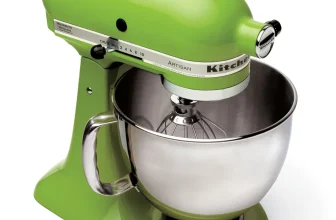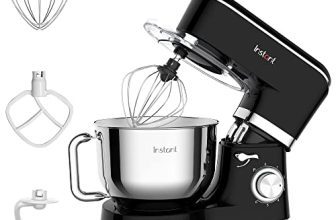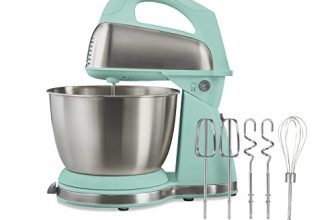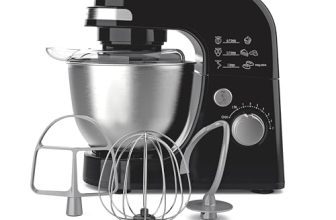As an Amazon Associate I earn from qualifying purchases.
How To Choose A Stand Mixer
How To Choose A Stand Mixer? Choosing the right stand mixer can transform your culinary experience, but did you know that nearly 70% of professional bakers consider it essential for efficiency and quality? Think back to the last time you prepped for a big bake: a good mixer could have shaved hours off your prep time and saved your arms from the strain of manual blending. Exceptional results are often rooted in the tools one uses.
When selecting a stand mixer, it’s crucial to assess the power and capacity needed for your typical recipes. A pivotal moment in the evolution of kitchen appliances, stand mixers have evolved from simple hand-crank variants to modern-day multifunctional marvels. With models boasting up to 500 watts of power, the choice can heavily influence the consistency and quality of your doughs and batters. Investing in a high-quality stand mixer isn’t just about convenience; it’s about unlocking potential in every culinary creation.
- Determine your baking needs: Consider the types and frequency of recipes you’ll be preparing.
- Assess power and capacity: Look for a mixer with at least 300 watts and a bowl size that suits your usual batches.
- Evaluate additional features: Check for multiple attachments, speed settings, and ease of cleaning.
- Examine durability: Opt for models with metal parts and strong brand reputations.
- Consider price and warranty: Balance cost against long-term value, ensuring there’s a reasonable warranty period.

How to Choose a Stand Mixer
When choosing a stand mixer, the first thing to consider is the power and capacity. A powerful motor, typically measured in watts, can handle thick doughs like bread and cookies with ease. You might need a mixer with at least 300 watts for most baking tasks. Capacity is equally important, so think about how much you usually bake. A 5-quart bowl is standard for most home bakers.
Next, evaluate the additional features of the stand mixer. Does it come with multiple attachments such as a dough hook, paddle, and whisk? Some mixers also offer extra accessories like pasta makers and meat grinders. These can make your mixer more versatile. Check if the mixer has speed settings to provide control for different recipes.
Durability is another key factor. A stand mixer should be sturdy and long-lasting. Look for models made with metal parts rather than plastic ones, as they tend to last longer. Some top brands provide warranties that indicate their trust in the product’s durability. Reading customer reviews can also give you an idea of a mixer’s longevity.
Finally, consider price and brand reputation. Prices for stand mixers can vary widely, from budget-friendly to high-end options. Popular brands like KitchenAid, Cuisinart, and Hamilton Beach are well-known for their reliability. While it’s tempting to go for a cheaper model, investing in a trusted brand can save you money and headaches in the long run.
Understand Your Baking Needs
Before purchasing a stand mixer, think about what you love to bake most often. If you’re into baking bread, a mixer with a powerful motor and dough hook is essential. For those who bake cookies and cakes, you’ll want a good beater attachment. Special features can make a big difference. Make a list of the recipes you frequently make to guide your decision.
Consider how often you’ll use the mixer. Regular bakers might benefit from a heavy-duty model whereas occasional bakers might prefer something simpler. Think about your kitchen space as well. A large, bulky mixer may not fit easily on your counter or in your cabinets. Measure your available space before making a purchase.
If you enjoy experimenting with new recipes, versatility is key. Look for mixers that offer multiple attachments and settings. These mixers allow you to try different techniques, from whipping egg whites to kneading pizza dough. Some mixers can even handle non-baking tasks, like grinding meat or making pasta. Having these options can expand your culinary horizons.
Finally, think about your budget and long-term investment. High-quality mixers can be pricey, but they often come with warranties and last longer. Cheaper models might save money upfront but may not handle heavy use. Read reviews and compare features to find a mixer that meets both your needs and budget. Prioritize what’s most important for your baking adventures.
Consider the Mixer’s Power and Capacity
When selecting a stand mixer, the power and capacity are crucial factors. Most home bakers will find that a mixer with 300 to 500 watts is sufficient. This power range can handle a variety of tasks, from mixing cake batter to kneading dough. High-wattage mixers are perfect for challenging recipes. They ensure consistent performance without overheating.
Capacity is another key aspect to consider. Mixers often come with bowls ranging from 3.5 to 7 quarts. A 5-quart bowl is adequate for most household needs, suitable for making multiple batches of cookies. Larger bowls are useful for big families or frequent entertaining. They allow you to mix larger quantities without overflowing.
It’s also essential to think about the type of mixing you’ll be doing most often. If you plan on mixing heavy doughs regularly, opt for a higher-capacity mixer. This type of mixer can manage the volume and weight without strain. Additionally, check if the mixer has multiple speed settings. These settings give you flexibility for different recipes.
Lastly, consider the overall build and weight of the mixer. A heavier base provides stability during operation. This reduces the chance of the mixer moving around on your countertop. Models with metal gears tend to be more durable. Investing in a well-built mixer ensures it will serve you well for years.
Evaluate Additional Features
When you’re choosing a stand mixer, additional features can be a game-changer. Attachments make mixers more versatile. Common attachments include dough hooks, wire whisks, and flat beaters. Some mixers even come with food processors or pasta makers. Having these extras can greatly expand your cooking options.
Another feature to consider is the number of speed settings. More speed options give you better control over your mixing. For example, low speeds are great for kneading dough, while higher speeds work well for whipping cream. Some mixers have up to 12-speed levels. Speed settings make a big difference in getting the texture just right.
Look for mixers with a tilt-head or bowl-lift design. Tilt-head mixers allow you to easily add ingredients and change attachments. Bowl-lift designs, on the other hand, are usually more stable and better for heavy-duty mixing. Each design has its pros and cons. Choosing one depends on your comfort and kitchen space.
Some stand mixers come with built-in timers. Timers help you keep track of mixing time, ensuring consistent results. This feature is especially useful for recipes that require precision. You can set it and forget it. It adds convenience and efficiency to your baking process.
Consider the ease of cleaning as well. Removable parts that are dishwasher-safe can save you a lot of time. Mixers with fewer crevices and smooth surfaces are easier to wipe down. By focusing on features that simplify cleaning, you can enjoy a hassle-free baking experience. Simple maintenance keeps your mixer in top condition.
Examine the Mixer’s Durability
Assessing a stand mixer’s durability is essential for long-term use. Mixers made with metal gears and components typically last longer. Plastic parts can break more easily under stress. Check the build quality before making a decision. A sturdy mixer could last you many years.
Pay attention to the brand’s reputation. Brands like KitchenAid and Cuisinart are known for their durable products. Look at reviews and user testimonials. These can provide insight into a mixer’s longevity. Reliable brands often offer good warranties as a sign of quality.
Warranties are a good indicator of durability. A longer warranty usually means the manufacturer trusts their product to last. Look for mixers with at least a one-year warranty. Some high-end models come with up to five-year warranties. Make sure to read the warranty terms carefully.
Weight is another factor that often implies durability. Heavier mixers are generally more stable and less likely to move while in use. These mixers often use heavier, more durable materials. Lighter models can be more convenient to move but may not last as long. Balance these considerations based on your needs.
Consider the overall design and engineering of the mixer. Well-engineered mixers are designed to withstand regular use without breaking down. They often feature better cooling systems to prevent overheating. This is especially important for frequent bakers. Good engineering also ensures consistent performance.
The ease of finding replacement parts is also important. Mixers with readily available replacement parts are more convenient to repair. This can extend their lifespan. Check if the brand offers easy access to spare parts. Investing in a mixer with easy-to-find parts can save you money and headaches in the long run.
Price and Brand Considerations
When selecting a stand mixer, the price can be a major factor. Budget-friendly mixers usually start at around $100, while high-end models can exceed $500. The extra cost often translates to better build quality and more features. It’s essential to weigh your budget against your needs. Spending a bit more upfront can save money on repairs and replacements.
Brand reputation is important when choosing a mixer. Established brands like KitchenAid, Cuisinart, and Hamilton Beach have a proven track record. These brands often provide better customer service and reliable warranties. Some lesser-known brands might offer cheaper options. However, they may not be as reliable in the long run.
Consider the features you get for the price. High-end models often come with multiple attachments and better speed control. These features can make a big difference in your baking results. Lower-priced mixers might lack some of these extras. Make a list of must-have features to find the best value for your money.
Customer reviews can be very informative. Look for reviews that mention durability, ease of use, and overall satisfaction. Reviews can reveal common issues that you might not consider. They also offer real-world insights into how a mixer performs over time. This information can help you make a more informed decision.
Your specific needs should guide your final choice. If you bake frequently, investing in a high-quality brand is wise. Occasional bakers might find a mid-range option more suitable. Align your brand choice and price range. Finding a good balance ensures you get the best mixer for your requirements.
The Impact of a High-Quality Stand Mixer on Your Baking
A high-quality stand mixer can have a significant impact on your baking. It offers consistent power and speed, ensuring even mixing of ingredients. This consistency is crucial for achieving the right texture in doughs and batters. With multiple speed settings, you can handle delicate tasks like whipping egg whites. The end result is more reliable, professional-level baked goods.
Another major benefit is the time and effort saved. Manual mixing can be physically exhausting and time-consuming. A powerful stand mixer handles heavy work with ease, allowing you to multitask. This efficiency means you can bake more frequently without feeling worn out. It brings enjoyment back into the baking process.
Versatility is another strong suit of high-end mixers. They often come with multiple attachments that perform various functions beyond just mixing. These include tasks like kneading bread dough, grinding meat, or even making pasta. Having one device that performs so many tasks simplifies your kitchen setup.
High-quality mixers are also built to last, providing long-term value. Investing in a durable model ensures you won’t face frequent breakdowns or need constant repairs. Brands with good reputations typically offer warranties that add extra peace of mind. Over time, this durability translates into cost savings.
The precision offered by these mixers shouldn’t be underestimated either. Precise mixing helps achieve exact results every time you bake, which is especially important for recipes requiring accuracy. Controlled speeds prevent overmixing or undermixing ingredients, preserving their intended texture and structure.
Stand Mixer Maintenance Tips
Maintaining your stand mixer is crucial for its longevity. After each use, clean the attachments, bowl, and exterior. Most attachments are dishwasher safe, but it’s good to check the manual. For the exterior, a damp cloth will usually do the trick. Keeping it clean prevents residue buildup that can affect performance.
Regularly inspect the power cord for any signs of wear and tear. A damaged cord can be hazardous. Replace it immediately if you notice fraying or cuts. Also, ensure the plug fits snugly into the outlet. Safety should always be a top priority in the kitchen.
Lubricating the moving parts is another essential maintenance task. Some mixers have a spot where you can add grease to keep the gears running smoothly. Follow the manufacturer’s instructions for this. It’s usually a simple process but makes a big difference. Oiled gears last longer and operate more quietly.
Using the mixer correctly also prolongs its life. Avoid overloading the bowl as this can strain the motor. Stick to the recommended speed settings for different tasks. For heavy dough, use the lower speeds. This prevents overheating and ensures smoother operation.
Store your stand mixer in a cool, dry place. Avoid areas with extreme temperatures or moisture, as these can damage the mixer. If possible, keep it covered when not in use. This protects it from dust and other potential damage. Proper storage keeps it ready for your next baking adventure.
Occasionally, check the mixer’s alignment and balance. If it starts wobbling during use, it could be a sign of imbalance. Tighten any loose screws or bolts. Ensuring everything is secure prevents further issues and keeps the mixer stable. Regular checks help maintain optimal performance.
Popular Stand Mixer Brands
Several brands have become household names when it comes to stand mixers. One of the most recognized is KitchenAid. Known for their durability and wide range of attachments, KitchenAid mixers are a favorite among home and professional bakers. They offer models in various colors and sizes. This brand is synonymous with quality and reliability.
Cuisinart is another popular name in the world of stand mixers. Cuisinart mixers are typically more budget-friendly while still offering excellent performance. They are well-regarded for their sturdy build and versatile attachments. Many users appreciate the ease of use and cleanup. This brand provides a good balance between cost and functionality.
Hamilton Beach is also worth mentioning. Known for their affordability, Hamilton Beach mixers are ideal for beginner bakers. Despite their lower price, these mixers do not compromise on essential features. Users often highlight their ease of use and efficiency. This brand is perfect for those looking to get started with baking without a significant investment.
Breville offers high-end stand mixers with advanced features. Breville mixers often come with intuitive controls and powerful motors. They are designed for serious bakers who require precision and versatility. Although they are on the pricier side, the quality justifies the cost. This brand is perfect for those who take their baking seriously.
Another brand to consider is Bosch. Bosch mixers are known for their innovative design and robust performance. They often come with powerful motors and a range of attachments. Many users appreciate their durability and efficiency. This brand is often recommended for those who need heavy-duty performance.
Each of these brands has its unique strengths, so the best choice depends on your specific needs and budget. Researching user reviews and comparing features can help you make an informed decision. Investing in a reliable brand ensures you get the most out of your stand mixer. The right mixer can make all your baking projects more enjoyable and successful.
The Evolution of Stand Mixers
Stand mixers have come a long way since their inception. The first stand mixers, invented in the early 1900s, were massive machines used primarily in commercial bakeries. These were large and cumbersome. However, they revolutionized baking by automating the mixing process. This made baking more efficient and consistent.
In the 1930s, the stand mixer was adapted for home use. Companies like KitchenAid started producing mixers suitable for domestic kitchens. These early models were still quite robust but smaller than their commercial counterparts. Home bakers began to appreciate the convenience. It wasn’t long before stand mixers became a kitchen staple.
Technological advancements have significantly improved stand mixers over the years. Modern mixers now come with multiple speed settings and various attachments. These features make them incredibly versatile. You can knead dough, whip cream, and even make pasta with the right attachments. The technology makes baking more accessible and enjoyable.
Design has also evolved to meet consumer demands. Today, mixers are available in various sizes and vibrant colors. Brands offer models with sleek, modern designs that complement contemporary kitchens. These aesthetic improvements make stand mixers not just functional but also stylish kitchen appliances. They blend seamlessly into modern decor.
Durability has always been a focus, but today’s mixers are built to last even longer. Advances in materials like stainless steel and high-quality plastics have enhanced longevity. Companies now offer extended warranties to back their products. This assures customers of their investment. A durable mixer is now not just an expectation but a standard.
The future of stand mixers looks bright with continuous innovation. Manufacturers are exploring smart technology that would allow users to control mixers via apps. These advancements could make baking even more convenient. The evolution of stand mixers shows no signs of slowing down. Each new development aims to make baking simpler and more enjoyable.
Frequently Asked Questions
If you’re considering buying a stand mixer, you might have several questions on your mind. Here are some common queries and their answers to help you make an informed decision.
1. What is the best type of bowl material for a stand mixer?
The best types of bowl materials are stainless steel, glass, and ceramic. Stainless steel bowls are durable and perfect for heavy-duty tasks. They are also lightweight and dishwasher-safe. Glass bowls allow you to see ingredients as they mix and can withstand extreme temperatures.
Ceramic bowls often come with lovely designs but are heavy and more breakable compared to other materials. Each material has its benefits depending on what you’re looking for in terms of functionality and aesthetics. Choose based on your specific needs and preferences.
2. How important is the motor wattage in a stand mixer?
The motor wattage is crucial as it determines how powerful the mixer will be. Higher wattage motors handle heavier doughs better and last longer without overheating. If you frequently bake bread or stiff cookie dough, opt for mixers with at least 300 watts. For lighter tasks like whipping cream, lower wattages will suffice.
A powerful motor ensures consistency in mixing results, which is vital for achieving perfect textures in your recipes. It also enhances the machine’s durability by reducing strain during operation. Don’t underestimate the impact of motor power when choosing a stand mixer.
3. Can I use my stand mixer to knead bread dough?
Yes, many stand mixers come equipped with dough hooks specifically designed for kneading bread dough. This feature saves time and effort compared to hand-kneading. Ensure your mixer has sufficient power—at least 300 watts—to handle the workload effectively without straining the motor.
Using your stand mixer to knead dough ensures even distribution of ingredients, resulting in consistently good bread texture and flavor. Follow manufacturer guidelines regarding speed settings to avoid overheating or damaging the machine during extended use.
4. Are attachments from different brands interchangeable?
Attachments are usually brand-specific due to varying design specifications, so they may not be interchangeable between different brands’ mixers. Before purchasing additional accessories, check compatibility information provided by manufacturers.
Mismatched attachments could lead to poor performance or damage both accessory and mixer components over time if forced into usage together incorrectly designed parts components critical double verify before attempting interchangeability situation arises save expenses future issues down line reliability work efficiency intended products combination used .
5 . How do I clean my stand mixer’s bowl attachments ?
Cleaning bowl attachments straightforward typically dishwasher safe – detach , place top rack cycle finished wipe external surfaces damp cloth ensure cleanliness hygienic purposes reference owners manual deter damage following stepwise given .
Regular maintenance critical preserving life quality appliance longevity ensure remove electrical outlet before cleaning moving parts store cool dry location prevent corrosion safeguard daily weekly intervals simple actions significant role maintaining optimal performance conditions avoiding costly repairs replacement ultimately hassle unnecessary downtime extended use
Conclusion
Choosing the right stand mixer is a crucial step for any baking enthusiast or professional. By understanding your needs, considering power and capacity, and evaluating additional features, you can find the perfect mixer. Durability and brand reputation are also key factors to ensure long-term satisfaction. Investing in a quality stand mixer will enhance your baking experience.
A high-quality stand mixer not only saves time but also delivers consistent results. With proper maintenance, your mixer can last for many years, making it a worthwhile addition to your kitchen. Whether you are a hobbyist or a professional, the right stand mixer can elevate your baking to new heights. Choose wisely and enjoy the benefits for years to come.






